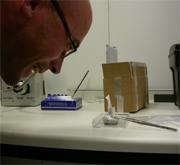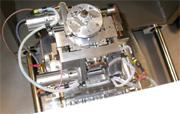 Phil Bland takes a close look at his bit of stardust.© Mark Peplow / Nature
Phil Bland takes a close look at his bit of stardust.© Mark Peplow / NatureIt's not every day you get to play with a comet's tail. And for Phil Bland, an expert on meteorites and space dust at Imperial College London, UK, it's like having all his birthdays come at once. "I keep having flashbacks to being a nine-year-old, dreaming about space," he grins.
"This is comet dust," he exclaims, brandishing an anonymous-looking cardboard box. "How cool is that?"
The box has just arrived from NASA's Johnson Space Center in Houston, Texas, but its contents have rather more distant origins. When the Stardust probe swooped low over the comet Wild 2 on 2 January 2004, it scooped up samples from the stream of dust that forms the comet's tail.
Embedded safely in a lightweight foam called aerogel, thousands of the tiny grains were parachuted back to Earth on 15 January after travelling more than a billion kilometres from the comet (see 'Comet dust delivered to Earth' ).
Stardust's scientists are wont to remind us, in hushed tones, that these grains are the first geological samples returned from space for 20 years. "It's also the first time we've ever got material from a comet," says Bland. Stardust skimmed just 240 kilometres above the 5-kilometre-wide comet nucleus, picking up dust that had blown off the comet's surface just minutes before.
Because comets are thought to be frosty leftovers from the Solar System's formation, that dust has a lot of history that could help to reveal where the Earth's oceans came from, and more besides.
Bland is one of the first scientists in the United Kingdom to get his hands on some of these grains, each just a few micrometres, or millionths of a metre, across. With so much precious dust to study, more than 150 teams around the world are making a preliminary analysis to find out what the probe brought back, and single out the most interesting samples for further research.
What's in the box?
Jittery with excitement, Bland opens up the box to reveal the objects of his affection, buried in bubble wrap. His team has received two types of randomly selected sample dust grains, prepared for them by staff at NASA to suit their analysis techniques. Both of these are the 'non-destructive' type: for the moment scientists are only allowed to look at the samples without altering them, saving them for further analyses down the line.
Bland's first sample is a credit-card-sized slab of plastic, which appears to be dotted with 50 poppy seeds arranged in a rectangular grid. Each of these grains, no bigger than the full stop at the end of this sentence, is a fraction of a dust particle.
 No clean room here: the epoxy bullet, holding a grain of material from a comet, is installed into the scanning electron microscope.© Mark Peplow / Nature
No clean room here: the epoxy bullet, holding a grain of material from a comet, is installed into the scanning electron microscope.© Mark Peplow / NatureThe second sample is made of epoxy resin and shaped like a small bullet. A single grain is embedded in the very tip, which has been sliced and polished to give a clean face. This is destined for the Natural History Museum's scanning electron microscope (SEM).
Electron scan
SEMs can resolve tiny structural details by watching how a stream of electrons bounce off a surface. But it can also reveal the presence of different chemical elements from the characteristic X-rays given off as the electrons collide with different atoms. So it should give Bland a first glimpse of the minerals inside the grain.
We take the sample to the SEM laboratory, followed by a gaggle of Bland's PhD students and resident SEM expert, Anton Kearsley. I expected clean-room conditions, with white paper suits and airlocks to prevent the samples becoming contaminated. How wrong I was. For these experiments, air exposure doesn't significantly affect the mineral chemistry, says Bland, which means that it's a lot easier to work with the samples.
That's just as well, as Bland is getting impatient. "Come on, let's have a look at it," he says, bouncing on his seat like a restless schoolboy.
"Three billion miles to get that?"
Kearsley cradles the epoxy bullet on a small mound of aluminium foil and places it delicately inside the machine, which is the size of a small refrigerator. He then manoeuvres the sample into precise position using twin joysticks, while an internal camera relays magnified images of the operation to a monitor. On screen, the bullet looks enormous, like a missile rolling into place in a Bond villain's underground silo.
With ten of us crowded into the small room, and the lights dimmed to avoid reflections on the screens, palpable tension steals over the group as we crane forward to see the SEM images as they rise out of a static fog.
And there, behold, a series of smooth, interconnected surfaces that look like a section from a geodesic dome: a perfect crystal. I'm impressed, until Kearsley explains that this is merely the tip of the epoxy bullet. The grain itself is there, he says, pointing at half a dozen bright pixels lost in the middle of the screen. "Three billion miles to get that?" mutters someone at the back of the room.
"Whatever it is, it's weird"
After fiddling around to improve the picture slightly, Kearsley starts a more intensive scan of the grain that will reveal its chemical make-up. As the analysis comes through, there are cries of surprise. "Whatever it is, it's weird," says Bland.
 Matt Genge has a crack at the credit-card-shaped slab of plastic holding a few more grains of dust.© Mark Peplow / Nature
Matt Genge has a crack at the credit-card-shaped slab of plastic holding a few more grains of dust.© Mark Peplow / NatureThe team agonize over the decision to make another scan to get more accurate results, but Kearsley is worried about "frying" the sample. "These grains have had a long journey and rather a lot of money spent on them," he cautions.
They can see that just a few minutes exposure to high-energy electrons has changed the structure of some of the epoxy surrounding the grain, so they finally decide that the initial results are so astonishing that they should contact Mike Zolensky at Johnson Space Center immediately to tell him about the find, and wait for further instructions. Zolensky is in charge of the preliminary analysis of the samples, and is collating all the information from these first tests.
Poor fit
The team discusses the first results over lunch, before the second set of samples in the credit-card grid are tackled in the afternoon by Bland's colleague Matt Genge. He wants to look at them using transmission electron microscopy (TEM), which delivers little chemical information but can show up a lot more of the grain's internal structure.
But after an hour of work, Genge admits defeat. The samples in the grid are a poor fit for the piece of brass designed to hold them inside the microscope, and the grid itself is so delicate that Genge fears damaging it irreparably. He plans to hunt down a different holder, delaying the experiment until the following week.
Meanwhile, Bland and Kearsley spend almost two hours putting an e-mail together to Zolensky. On several occasions they are about to send the images and data, but suddenly notice another feature that sets them off on a different train of thought, delaying the e-mail.
Wild and wacky
By the time the e-mail is finally sent, the day is almost done. Bland will travel to Liverpool University, UK, the following week to use another type of electron microscope that should reveal more about the structure of crystals in the samples, helping to pin down exactly what they are made of, and what conditions they formed in.
ADVERTISEMENT
"But the first day was as exciting as I'd anticipated," says Bland. "And to actually find something wacky straight off was way more than I expected."
Exactly what Bland found, however, isn't yet public information. NASA is keen for all the results, from the many teams around the world, to be gathered together before they are announced. "If it comes out in dribs and drabs it'll be total chaos," explains Zolensky. He and his team will put together all the results, which they expect to present at the Lunar and Planetary Science Conference in Houston, Texas, in March.
"We're just happy we've done our bit," says Bland.
But Bland is still optimistic that their unusual find could get special attention. "I'll be jumping up and down at the back, shouting, 'That's my grain!'" he says.
Post a comment to this story by visiting our cometstale.html">newsblog.
